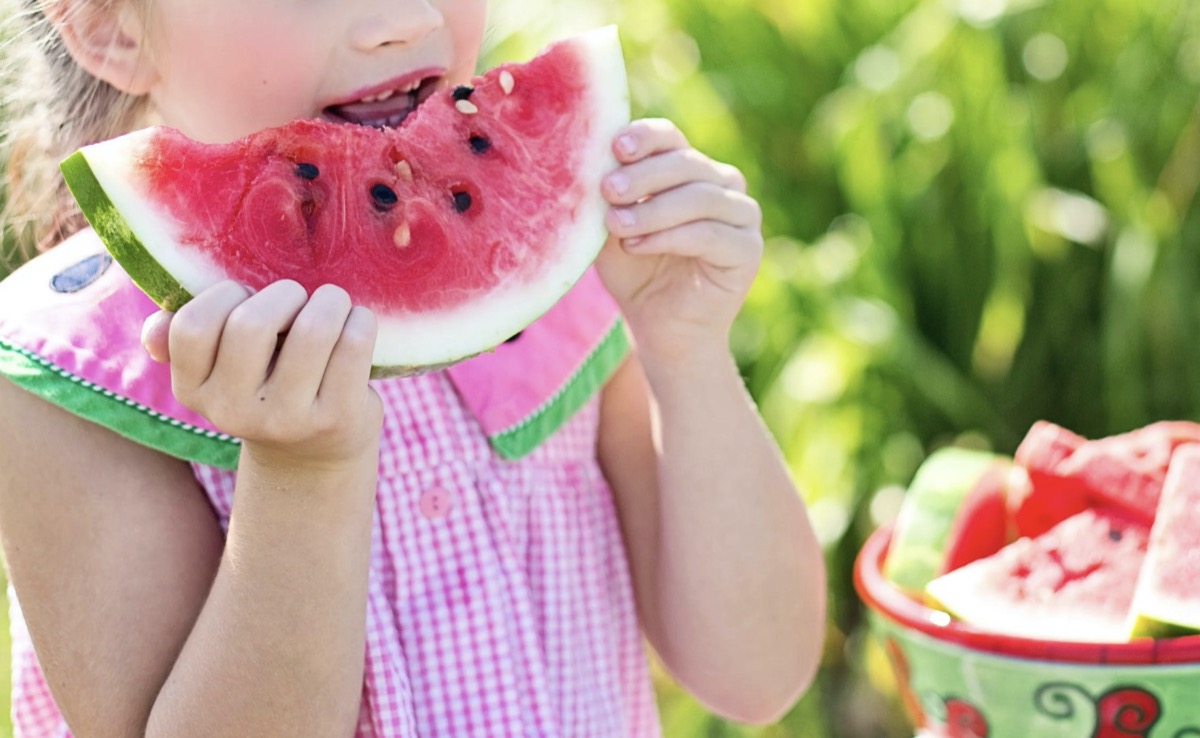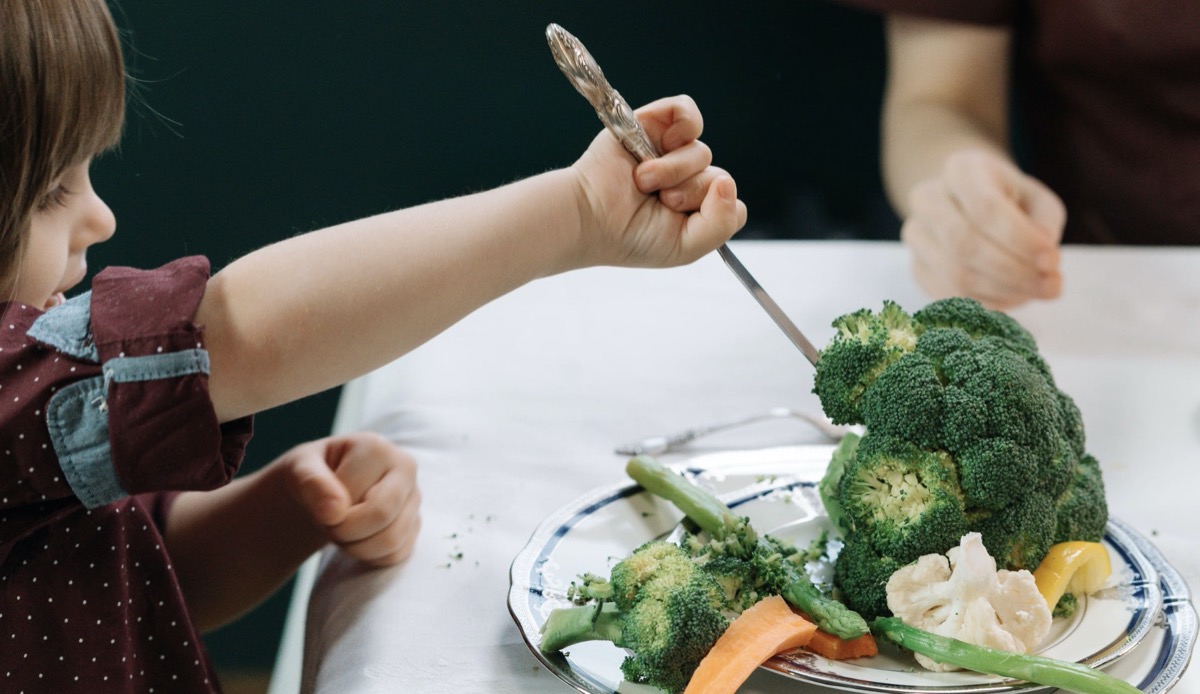Setting Good Food Examples for Young Children

So, you’re wondering how to model balanced eating for the young children in your life. Maybe you’re babysitting a group of kids whose parents you know don’t have the healthiest relationship with food; maybe you’re raising a pack of your own children; or maybe you work with kids every day. Whatever the situation, there are steps you can take to model balanced eating for those kiddos!
The first step is to be sure you’re clear on what ‘balanced eating’ is. Principles of balanced eating include that it honors hunger and fullness cues, that moderation is used with foods that could give you a stomach ache, that good variety is incorporated, and that you’re not following a restrictive diet of any kind (unless you have a medical condition like an allergy, of course). If you’re able to carry these principles out in the way you eat, you’ll be able to model balanced eating for young children. What follows are some concrete ways to incorporate the principles of balanced eating into your life and those of the children in your life!
Practice and Encourage Intuitive Eating (IE)
Signs you’re already an intuitive eater include you rarely feel extremely hungry or full, you get good variety in your diet, and you include all food groups with moderation (including carbs and sweets!). The basic gist of IE is to listen to and honor your hunger and fullness cues. IE also encompasses eating at times when you might not be hungry or you might be a little full, such as grabbing an ice cream cone at the carnival, or going for another hot dog at the BBQ.
We are all born with the ability to eat intuitively; just look at the really small children in your life. An infant will cry when he is hungry and stop drinking when he is full — a perfect model for intuitive eating. But, as life goes on, there are many factors that can derail a child from eating intuitively like this.
For example, if a child is always told to make sure his plate is clean, he’ll stop paying attention to his hunger and fullness cues and instead pay attention to just completing whatever is on the plate. This can often mean a child will eat past the point of comfortable fullness. But because he is rewarded for finishing all his food, there is no reason for him to ever consider whether his body actually wants to clean that plate or not.

Similarly, without realizing it, a parent might give their child a cookie any time she starts to cry. Over time, this will teach the child that an effective way of soothing her negative emotions is eating cookies. Don’t get me wrong, we all need a comfort cookie from time to time. But training a child from the early years that negative emotions should be handled with food sets a child up for emotion-based eating, not intuitive eating.
To help a child eat more intuitively, model IE yourself, let them eat when they are hungry and stop when they are full, and help them learn healthy ways to cope with negative emotions (such as talking about what they are experiencing, journaling, or taking a quiet moment to themselves). If you struggle with eating intuitively, or if your child exhibits extreme pickiness despite your best modeling efforts, consider working with a dietitian to help everyone get on track!
Let Food Be Food — It Should Be Neutral
It can be so difficult to make food a neutral part of life, especially if you’re dealing with a picky eater. Who doesn’t want to cheer for their kid when they finally take a bite of that once-despised food?! However, these types of responses to eating can cause undue attention on the act of eating and lead to confusion for the child.
There are a number of reasons why a child might not eat a specific food (or an array of specific foods), but these can often be overcome by neutralizing food. What do I mean by neutralizing food?
Food is often made to be an emotional experience. You might find yourself saying things like,
- Why can’t you just finish what is on your plate??
- If you don’t eat your carrots, you’re going to sit in time out!
- Good job, buddy! You ate the broccoli! Hooray!

Instead of attaching emotions to food and eating around a child, work to keep food as neutral as possible. You can cheer when a child eats broccoli after months of refusing it, but do so only in your mind. You can feel upset when a child continues to refuse a food, but again, do so only in your mind. Any attention you draw to a child’s response to food, whether your attention is positive or negative, can cause the child to hyper-focus on that food. If the evil food is broccoli, for example, and you are visibly upset when the child refuses it, broccoli will become ‘the disgusting food this person wants me to eat’ instead of simply broccoli.
Negative or positive responses to behavior around food can reinforce behaviors you don’t want to continue to take place. When you keep food neutral, you open the natural potential for a child to explore a food on their own, which is what children love to do with most things!
Food Exposure Works
While you’re working on keeping food neutral, you can also repeatedly expose your child to different foods. Repeated food exposures increase familiarity with a food and really increase the likelihood the child will eventually eat that food, even if he’s tried it and absolutely hated it before.
Let’s say the small child in your life will not eat chicken. You don’t need to give her chicken with every meal for an effective food exposure; just put some chicken on her plate any time you cook it. This might be once a week, or even once a month. Be sure there are other foods the child will eat alongside the food in question, and watch what happens while maintaining neutrality.
If the child does not touch the chicken the first few times, leave it at that. Ask her if she’s finished or wants more food, then take it away. Studies show a child may need to be exposed to a food anywhere from 10 to 30 times before they are comfortable eating it. So, be patient! It may be a long time before she takes even one bite of it, but it will likely happen eventually. And be sure to be getting good variety yourself! Children pay much closer attention than we often give them credit for.
In Conclusion
Modeling balanced eating for small children is an important way to help them become balanced eaters themselves. Eating intuitively, working to neutralize food, and making sure there is exposure to good variety will all help set up the children in your life to be healthy eaters one day.
Grace Engels is a registered dietitian and content writer based in the Greater NYC Area. As an anti-diet dietitian specializing in eating disorders, Grace believes that all foods fit and that everyone deserves respect no matter what size their bodies are. She can be reached at grace@graceengels.com.